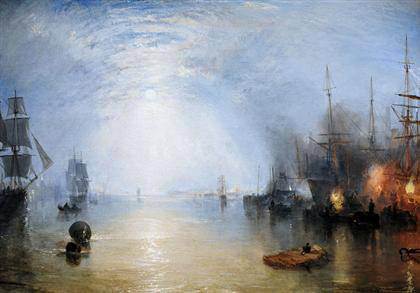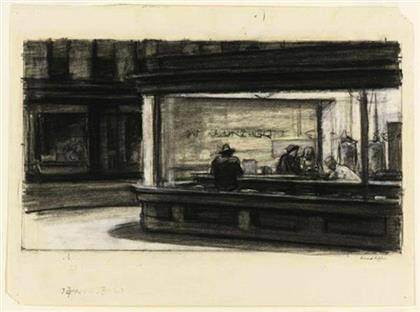
Joseph Mallord William Turner
Keelmen Heaving in Coals by Moonlight (1835)

Joseph Mallord William Turner
The Fighting ‘Temeraire’ (1839)
Turner and the Sea at the National Maritime Museum ‘Turner and the Sea’ at the National Maritime Museum, Greenwich, is the first full-scale examination of J.M.W Turner’s lifelong fascination with the sea. 22 November 2013–21 April 2014.]]>
Source: National Maritime Museum, Greenwich
Dramatic, contemplative, violent, beautiful, dangerous and sublime – the sea was the perfect subject to showcase Turner’s singular talents, and the 120 pieces on display include some of the most celebrated paintings of the artist’s long career.
The extraordinary quality of the works gathered together for “Turner and the Sea” confirms his status as the pre-eminent painter of water, and demonstrates his unique ability to represent the elemental power of the sea. The exhibition features items on loan from some of the world’s most prestigious artistic institutions including: The National Gallery, Tate, Yale Center for British Art, British Museum, Metropolitan Museum of Art, Royal Collection Trust, Calouste Gulbenkian Foundation, Lisbon and National Gallery of Art, Washington.
From his transformative Royal Academy paintings of the late 1790s and early 1800s to the unfinished, experimental seascapes he produced towards the end of his life, more than half of Turner’s artistic output depicted maritime subjects. It should come as no surprise that a man who spent much of his life along the coastlines of Britain and Europe, who spent days fishing the river Thames, and who reportedly had himself lashed to the mast of a ship to better paint a storm at sea, captured this subject so often and with such evocative mastery. Nonetheless, the sheer volume of material Turner created in his quest to depict the sea is remarkable.
The Fighting ‘Temeraire’ (1839), Snow Storm – Steam-Boat off a Harbour’s Mouth (1842), Staffa, Fingal’s Cave (1832), ‘Now for the Painter’ (1827), Keelmen Heaving in Coals by Moonlight (1835), Whalers (c.1845) and Calais Pier (1803) are shown, alongside works by other major British and European artists, including Willem van de Velde, Claude-Joseph Vernet, Thomas Gainsborough, Nicholas Pocock, John Constable and Richard Parkes Bonington. Further highlights include: Turner’s largest painting and only royal commission, The Battle of Trafalgar (1824), one of the jewels in the National Maritime Museum’s fine art collection; Fishermen at Sea, the first oil painting Turner exhibited at the Royal Academy; The Wreck of a Transport Ship (c.1810), not seen in London since 1970s, displayed alongside The Shipwreck (1805) and Calais Pier – the first time these three storm paintings have been shown together; and The Wreck Buoy (1849), Turner’s last exhibited marine painting.
Related content
Turner from the Tate – The Making of a Master (exhibition in Australia, 2013)
Follow us on:


